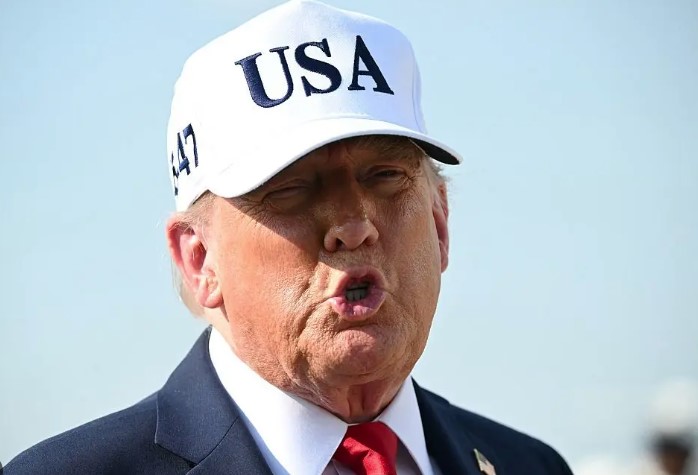US President Donald Trump announced a major update in how the United States provides weapon support to Ukraine.
NATO to Act as Middleman in Weapon Transfers
This update comes in the context of Ukraine’s ongoing war with Russia. Trump stated that the US will now send American weapons to Ukraine through NATO allies. The weapons will not be sent directly to Ukraine. Instead, NATO allies in Europe will handle the weapon transfers. According to Trump, these allies will pay 100% of the cost before transferring the weapons to Ukraine.
Trump made this announcement in an interview with NBC News. He said, “We’re sending weapons to NATO, and NATO is paying for those weapons, 100%. The weapons that are going out are going to NATO, and then NATO is giving them to Ukraine.”
This means the US is no longer footing the bill directly. Instead, its NATO partners in Europe will buy the weapons, and Ukraine will receive them from those allies. Trump said he chose this strategy in response to Russia’s recent heavy drone and missile attacks on Ukraine.
🛑 Hegseth Acts Alone on Ukraine Weapons — White House, State Dept, and Trump Left in the Dark
The US plan comes over three years after Russia first invaded Ukraine. While the Trump administration has changed its approach several times, the most recent plan focuses on indirectly supplying Ukraine with defensive weapons while having NATO nations carry the financial burden.
European Weapon Stockpiles Could Be Sent to Ukraine First
US Secretary of State Marco Rubio explained that some of the weapons Ukraine needs are already in Europe. These weapons are currently deployed with NATO member countries. Instead of making new weapons in US factories, NATO allies can transfer existing ones more quickly. Countries like Germany or Spain already have these weapons in their stockpiles. Sending them from Europe to Ukraine saves time.
“We can move something from Germany to Ukraine much faster than ordering it from a factory and shipping it,” Rubio said while speaking to reporters in Malaysia.
Rubio further explained that NATO countries already using US-made weapons can send those to Ukraine and then buy replacements directly from the United States. This process helps save time and keeps Ukraine supplied more efficiently during urgent attacks.
Germany, Spain, and other European countries have Patriot missile systems, which Ukraine says it urgently needs. Some of these nations have already placed orders for more Patriot systems, suggesting they may be preparing to replace the ones they could send to Ukraine.
Zelenskyy Warns US Support Is Key to Stopping Russia’s NATO Aggression
A NATO spokesperson confirmed that member countries are working together to get the necessary supplies to Ukraine, including air defense systems and ammunition. While NATO itself does not own or deliver weapons, it plays a key role in coordinating deliveries through a logistics hub in Poland, close to Ukraine’s border.
An unnamed NATO military official added that Trump had already discussed the plan with NATO Secretary-General Mark Rutte. A senior European defense official said the understanding is clear—European countries will buy the weapons from the US and send them to Ukraine.
Recent Russian Attacks Increase the Urgency
This new plan follows a series of heavy Russian drone and missile attacks on Ukraine. Trump mentioned that Ukraine is being “hit very hard,” which is one reason behind the push to speed up military support.
This week, Russia launched more than 700 attack and decoy drones toward Ukraine, setting a new record for the third time in just two weeks. These aerial strikes are designed to overwhelm Ukraine’s air defense systems, and the damage has been severe.
One of the latest attacks happened in Kharkiv, Ukraine’s second-largest city. A Russian drone strike hit a maternity hospital and injured nine people, according to local officials. Just hours later, another drone attack in the southern city of Odesa also injured nine people.
Ukrainian President Volodymyr Zelenskyy said the country needs at least 10 more Patriot systems to defend against these types of attacks. “There is no silence in Ukraine,” he said, highlighting the constant threat from Russian drones and missiles.
Red Line Crossed: NATO Bases Now Just Miles from Russia’s Border — Kremlin Issues Stark Warning
Trump, in a cabinet meeting earlier this week, also commented on the human cost of the war. He said he was “not happy” with Russian President Vladimir Putin because the conflict is “killing a lot of people on both sides.” Trump hinted that a major announcement on Russia would come soon, but did not provide more details.
For now, the focus remains on moving weapons quickly and efficiently to Ukraine. According to a NATO official, “NATO has effective mechanisms in place to make something like this possible.” European nations are paying for US-made weapons and transferring them to Ukraine, marking a significant shift in how countries now deliver military aid.
